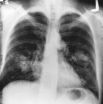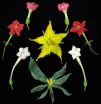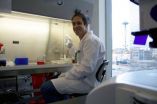(Press-News.org) ANN ARBOR—A thin, flexible electrode developed at the University of Michigan is 10 times smaller than the nearest competition and could make long-term measurements of neural activity practical at last.
This kind of technology could eventually be used to send signals to prosthetic limbs, overcoming inflammation larger electrodes cause that damages both the brain and the electrodes.
The main problem that neurons have with electrodes is that they make terrible neighbors. In addition to being enormous compared to the neurons, they are stiff and tend to rub nearby cells the wrong way. The resident immune cells spot the foreigner and attack, inflaming the brain tissue and blocking communication between the electrode and the cells.
The new electrode developed by the teams of Daryl Kipke, a professor of biomedical engineering, Joerg Lahann, a professor of chemical engineering, and Nicholas Kotov, the Joseph B. and Florence V. Cejka Professor of Engineering, is unobtrusive and even friendly in comparison. It is a thread of highly conductive carbon fiber, coated in plastic to block out signals from other neurons. The conductive gel pad at the end cozies up to soft cell membranes, and that close connection means the signals from brain cells come in much clearer.
"It's a huge step forward," Kotov said. "This electrode is about seven microns in diameter, or 0.007 millimeters, and its closest competitor is about 25 to 100 microns."
The gel even speaks the cell's language, he said. Electrical impulses travel through the brain by movements of ions, or atoms with electric charges, and the signals move through the gel in the same way. On the other side, the carbon fiber responds to the ions by moving electrons, effectively translating the brain's signal into the language of electronic devices.
To demonstrate how well the electrode listens in on real neurons, Kipke's team implanted it into the brains of rats. The electrode's narrow profile allows it to focus on just one neuron, and the team saw this in the sharp electrical signals coming through the fiber. They weren't getting a muddle of multiple neurons in conversation. In addition to picking up specific signals to send to prosthetics, listening to single neurons could help tease out many of the brain's big puzzles.
"How neurons are communicating with each other? What are the pathways for information processing in the brain? These are the questions that can be answered in the future with this kind of technique," Kotov said.
"Because these devices are so small, we can combine them with emerging optical techniques to visually observe what the cells are doing in the brain while listening to their electrical signals," said Takashi Kozai, who led the project as a student in Kipke's lab and has since earned his Ph.D. "This will unlock new understanding of how the brain works on the cellular and network level."
Kipke stressed that the electrode that the team tested is not a clinical trial-ready device, but it shows that efforts to shrink electrodes toward the size of brain cells are paying off.
"The results strongly suggest that creating feasible electrode arrays at these small dimensions is a viable path forward for making longer-lasting devices," he said.
In order to listen to a neuron for long, or help people control a prosthetic as they do a natural limb, the electrodes need to be able to survive for years in the brain without doing significant damage. With only six weeks of testing, the team couldn't say for sure how the electrode would fare in the long term, but the results were promising.
"Typically, we saw a peak in immune response at two weeks, then by three weeks it subsided, and by six weeks it had already stabilized," Kotov said. "That stabilization is the important observation."
The rat's neurons and immune system got used to the electrodes, suggesting that the electronic invaders might be able to stay for the long term.
While we won't see bionic arms or Iron Man-style suits on the market next year, Kipke is optimistic that prosthetic devices could start linking up with the brain in a decade or so.
"The surrounding work of developing very fine robotic control and clinical training protocols—that work is progressing along its own trajectory," Kipke said.
###
Kipke, director of the Center for Neural Communication Technology, is a professor of biomedical engineering. Kotov, the Joseph B. and Florence V. Cejka Professor of Engineering, is a professor of biomedical engineering, chemical engineering, biomaterials science and engineering, and macromolecular science and engineering. Lahann, director of the Biointerfaces Institute, is a professor of chemical engineering, materials science and engineering, biomedical engineering, and macromolecular science and engineering.
A paper on the research, "Ultra-small implantable composite microelectrodes with bioactive surfaces for chronic neural interfaces," is published in the current edition of Nature Materials. The work is funded by the National Institutes of Health and the Center for Neural Communication Technology, an NIH-funded biotechnology research center.
Daryl Kipke: http://sitemaker.umich.edu/daryl.kipke/home
A better brain implant: Slim electrode cozies up to single neurons
2012-11-12
ELSE PRESS RELEASES FROM THIS DATE:
Gene variations linked to lung cancer susceptibility in Asian women
2012-11-12
An international group of scientists has identified three genetic regions that predispose Asian women who have never smoked to lung cancer. The finding provides further evidence that risk of lung cancer among never-smokers, especially Asian women, may be associated with certain unique inherited genetic characteristics that distinguishes it from lung cancer in smokers.
Lung cancer in never-smokers is the seventh leading cause of cancer deaths worldwide, and the majority of lung cancers diagnosed historically among women in Eastern Asia have been in women who never smoked. ...
Detection, analysis of 'cell dust' may allow diagnosis, monitoring of brain cancer
2012-11-12
A novel miniature diagnostic platform using nuclear magnetic resonance (NMR) technology is capable of detecting minuscule cell particles known as microvesicles in a drop of blood. Microvesicles shed by cancer cells are even more numerous than those released by normal cells, so detecting them could prove a simple means for diagnosing cancer. In a study published in Nature Medicine, investigators at the Massachusetts General Hospital (MGH) Center for Systems Biology (CSB) demonstrate that microvesicles shed by brain cancer cells can be reliably detected in human blood through ...
Researchers discover 2 genetic flaws behind common form of inherited muscular dystrophy
2012-11-12
SEATTLE – An international research team co-led by a scientist at Fred Hutchinson Cancer Research Center has identified two genetic factors behind the third most common form of muscular dystrophy. The findings, published online in Nature Genetics, represent the latest in the team's series of groundbreaking discoveries begun in 2010 regarding the genetic causes of facioscapulohumeral muscular dystrophy, or FSHD.
The team, co-led by Stephen Tapscott, M.D., Ph.D., a member of the Hutchinson Center's Human Biology Division, discovered that a rare variant of FSHD, called type ...
Touch-sensitive plastic skin heals itself
2012-11-12
Nobody knows the remarkable properties of human skin like the researchers struggling to emulate it. Not only is our skin sensitive, sending the brain precise information about pressure and temperature, but it also heals efficiently to preserve a protective barrier against the world. Combining these two features in a single synthetic material presented an exciting challenge for Stanford Chemical Engineering Professor Zhenan Bao and her team.
Now, they have succeeded in making the first material that can both sense subtle pressure and heal itself when torn or cut. Their ...
36 in one fell swoop -- researchers observe 'impossible' ionization
2012-11-12
This press release is available in German.
Using the world's most powerful X-ray laser in California, an international research team discovered a surprising behaviour of atoms: with a single X-ray flash, the group led by Daniel Rolles from the Center for Free-Electron Laser Science (CFEL) in Hamburg (Germany) was able to kick a record number of 36 electrons at once out of a xenon atom. According to theoretical calculations, these are significantly more than should be possible at this energy of the X-ray radiation. The team present their unexpected observations in the ...
'Groundwater inundation' doubles previous predictions of flooding with future sea level rise
2012-11-12
Scientists from the University of Hawaii at Manoa (UHM) published a study today in Nature Climate Change showing that besides marine inundation (flooding), low-lying coastal areas may also be vulnerable to "groundwater inundation," a factor largely unrecognized in earlier predictions on the effects of sea level rise (SLR). Previous research has predicted that by the end of the century, sea level may rise 1 meter. Kolja Rotzoll, Postdoctoral Researcher at the UHM Water Resources Research Center and Charles Fletcher, UHM Associate Dean, found that the flooded area in urban ...
Game changer for arthritis and anti-fibrosis drugs
2012-11-12
(SALT LAKE CITY)—In a discovery that can fundamentally change how drugs for arthritis, and potentially many other diseases, are made, University of Utah medical researchers have identified a way to treat inflammation while potentially minimizing a serious side effect of current medications: the increased risk for infection.
These findings provide a new roadmap for making powerful anti-inflammatory medicines that will be safer not only for arthritis patients but also for millions of others with inflammation-associated diseases, such as diabetes, traumatic brain injury, ...
CSHL-led team discovers new way in which plants control flower production
2012-11-12
Cold Spring Harbor, N.Y. – Flowers don't just catch our eyes, they catch those of pollinators like bees as well. They have to, in order to reproduce. Because plants need to maximize the opportunity for pollinators to gain access to their seeds, variations in the timing of flowering can have profound effects on flower, fruit, and seed production, and consequently agricultural yields.
We know that the major driving forces of flowering are external factors such as light and temperature. However, new research from CSHL Assistant Professor Zach Lippman, Ph.D. and his collaborators, ...
Mutations in genes that modify DNA packaging result in Facioscapulohumeral Muscular Dystrophy
2012-11-12
A recent finding by medical geneticists sheds new light on how Facioscapulohumeral Muscular Dystrophy develops and how it might be treated. More commonly known as FSHD, the devastating disease affects both men and women.
FSHD is usually an inherited genetic disorder, yet sometimes appears spontaneously via new mutations in individuals with no family history of the condition.
"People with the condition experience progressive muscle weakness and about 1 in 5 require wheelchair assistance by age 40," said Dr. Daniel G. Miller, University of Washington associate professor ...
Study provides recipe for 'supercharging' atoms with X-ray laser
2012-11-12
Researchers using the Linac Coherent Light Source (LCLS) at the U.S. Department of Energy's (DOE) SLAC National Accelerator Laboratory have found a way to strip most of the electrons from xenon atoms, creating a "supercharged," strongly positive state at energies previously thought too low.
The findings, which defy expectations and theory, could help scientists deliberately induce the high levels of damage needed to study extreme states of matter or ward off damage in samples they're trying to image. The results were reported this week in Nature Photonics.
While the ...





